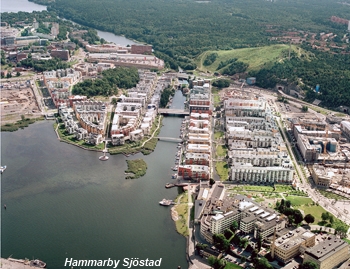|
|
|
|
|
|
|
News & Views item - August 2011 |
![]() Stockholm Was Named the First European Green Capital in 2010. (August 16,
2011)
Stockholm Was Named the First European Green Capital in 2010. (August 16,
2011)
 Stockholm,
Sweden's Hammarby Sjöstad district is, according to a recent article in Time
one of the world's most successful eco-villages. It was initially intended to
form part of Stockholm's bid to host the 2004 Summer Olympic Games.While the bid
was unsuccessful, it acted as a catalyst to continue to design and plan a pilot
for an environmentally-friendly housing development in order to meet the strong
demand for new housing.
Stockholm,
Sweden's Hammarby Sjöstad district is, according to a recent article in Time
one of the world's most successful eco-villages. It was initially intended to
form part of Stockholm's bid to host the 2004 Summer Olympic Games.While the bid
was unsuccessful, it acted as a catalyst to continue to design and plan a pilot
for an environmentally-friendly housing development in order to meet the strong
demand for new housing.
According to its Website, the intention when complete, is to have 11,000 residential apartments, along with "comprehensive provision of new public transport links, leisure facilities and green public spaces. To date 6,600 homes have been built, and the area has been transformed from a polluted ex-industrial site to a popular neighbourhood for young families".
Buses are powered by biogas, recycled rainwater is utilised for irrigation and organic waste for fertiliser, and the development is acting as an incentive for other districts of the "Venice of the North".
With the naming in 2010 of Stockholm as the first European Green Capital "green innovation has become a pillar of Swedish national competitiveness. It intends to become fossil-fuel-free by 2050, and has visions of exporting 'smart power' to an energy-conscious world".
Time reports that a smart electricity grid, using renewable energy (including solar and wind ), will not only service offices and residents they in turn will feed back into the system when in surplus. The expectation is that yearly carbon emissions will be reduced to less than 1.5 tons per person by 2020 — the Australian average (2008) was 18.9 metric tons per person per annum while the Swedes expelled 5.4 metric tons. For comparison New Zealand = 7.8 mt/pa.
Finally, because Hammarby Sjöstad will be the new Royal Seaport, ships will be able to connect to the onshore grid allowing their engines to shut down while in port making the harbour area more attractive in which to live and further reducing CO2 emissions.